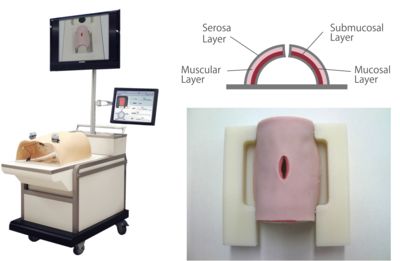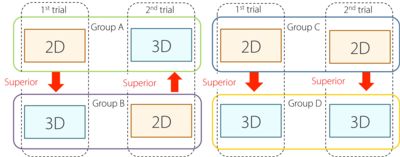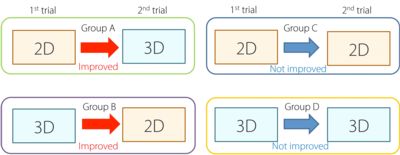Munenori Uemura, PhD1, Makoto Yamashita1, Morimasa Tomikawa, MD, PhD, FACS1, Satoshi Obata, MD1, Takahiro Jimbo, MD1, Noriyuki Matsuoka2, Makoto Hashizume, MD, PhD, FACS1, Yoichi Nakanishi, MD, PhD1. 1Kyushu University, 2Kyoto Kagaku Co., Ltd
PURPOSE: Three-dimensional (3D) visualization has been shown to improve surgical performance. The effectiveness of 3D endoscopy has previously been measured by conventional criteria such as the path lengths of the operative instruments, the number of loose or inaccurately placed sutures among other skill-based errors. However, the quality of suture task performance, i.e., the effectiveness of the suture itself, has never been evaluated using 3D vision. This study uses our newly developed alternative and more clinically applicable method of suture task performance analysis (Fig. 1). The system evaluates performance quality using pressure-measuring and image-processing devices in combination with an artificial intestinal model. By measuring four criteria that define an effective suture as well as suture task completion time, the efficacy of 3D vision can be evaluated and compared with conventional laparoscopy (Fig. 2).


The purpose of this study was to suggest a novel measurement methodology of performance evaluation of medical equipment using a new computerized objective assessment system.
METHODS AND PROCEDURES: The participants were 32 medical students who had no experience in performing laparoscopic surgeries. They had taken enough training over 2 weeks to complete the task. The participants were divided into four groups, and performed the mimic intestinal suturing task with our developed simulator under two-dimensional (2D) and 3D endoscope conditions. Group A performed the task with 2D first, then with 3D; Group B performed the task with 3D first, then with 2D; Group C performed the task with 2D first, then with 2D; and Group D performed the task with 3D first, then with 3D.
The performance scores of each group in both conditions were then compared.
RESULTS: There were significant differences between 2D and 3D in volume of air pressure leak (12.43 ± 9.16 kPa and 22.62 ± 11.07 kPa, respectively), number of full-thickness sutures (2.00 ± 0.87 pairs and 2.88 ± 0.33 pairs), suture tension (53.19 ± 16.52 % and 63.56 ± 10.63 %), and operation time (1170.25 ± 242.75 s and 840.00 ± 151.60 s) (Fig. 3a). There were no significant differences between the first and second trial in the same condition (Groups C and D) (Fig. 3b).


CONCLUSIONS: The usefulness of the 3D endoscope was evaluated objectively and quantitatively using the objective skill assessment system.
3D endoscope might be superior to 2D endoscope for performing laparoscopic surgeries intuitively.
Our proposed suggestion would be an effective way to evaluate the performance of medical equipment.